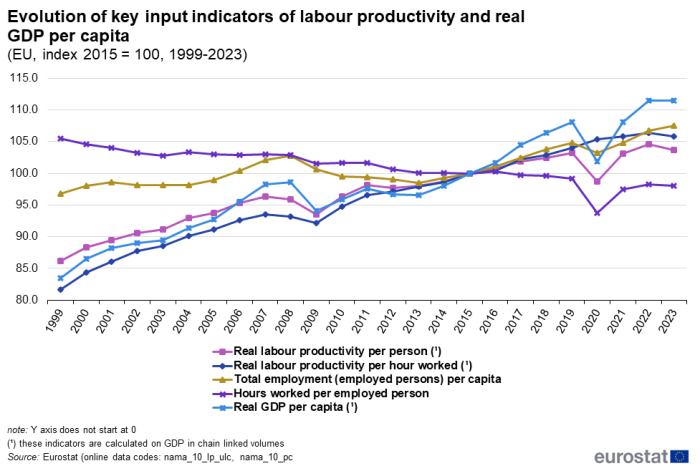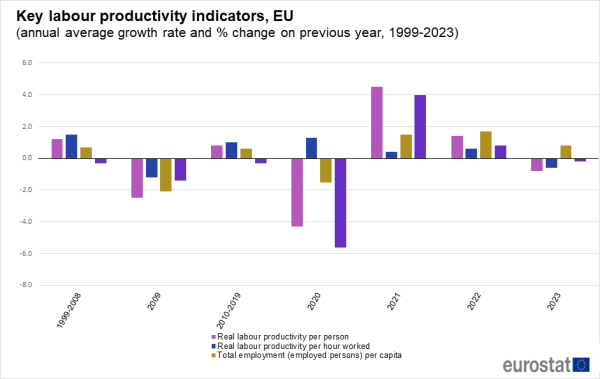Productivity trends using key national accounts indicators
Data extracted on 15 March 2024
Planned article update: March 2025
Highlights
Labour productivity per hour worked in the EU declined by 0.6 % in 2023, following a positive growth trend maintained even during the COVID-19 pandemic.
Labour productivity per person in the EU decreased by 0.8 % in 2023, but recovered from its sharp drop during COVID-19 pandemic.
This article uses indicators on the development of labour and capital inputs, including total economy and regional breakdowns to analyse European Union (EU) productivity trends since 1999 and provide insights into main trends and driving factors.
The data show how the financial crisis in 2009 and the COVID-19 pandemic in 2020 impacted the overall growth trends of (real) labour productivity per hour worked, per person and real GDP per capita as well as additional indicators on total employment per capita and hours worked per employed person. Except for productivity per hour worked, drops in 2020 were followed by marked recoveries in 2021 that continued in 2022. In 2023, all indicators except total employment per capita declined or stagnated. Nevertheless, the levels of indicators are still above the pre-pandemic levels, with exception of hours worked per employed person which continued on a downward trend.
Full article
Evolution of key indicators 1999-2023
Looking at the evolution of labour productivity per hour worked, per person and real GDP per capita since 1999, it can be seen that the overall growth trends were mostly interrupted by the financial crisis in 2009 and by the COVID-19 pandemic in 2020. Both these events had significant effects on the European Union (EU) economy.
However, a distinct feature of the 2020 pandemic is that labour productivity per hour worked continued to grow slightly during the pandemic period, because the decline in hours worked was greater than the decline in GDP, while labour productivity per person decreased as a result of the short-term work schemes put in place to preserve employment.
Then, key national accounts indicators showed a recovery, beginning with a considerable rebound in 2021 that was confirmed in 2022 for real GDP per capita (6.1 % and 3.2% respectively), labour productivity per person (4.5 % and 1.4 %) and hours worked per person (4.0 % and 0.8%). This positive trend was disrupted in 2023, but indicators remained above pre-pandemic levels, except for hours worked per employed person, which continued its downward trend.
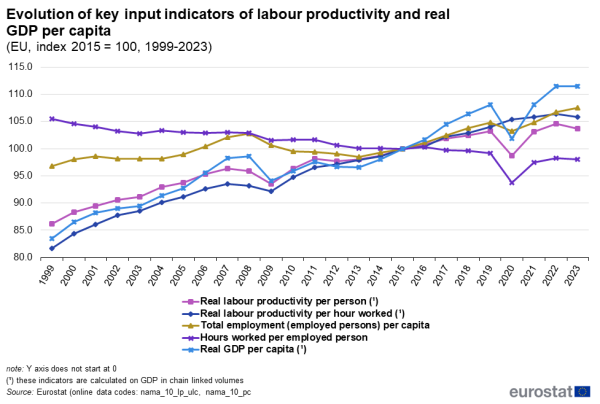
Source: Eurostat (nama_10_lp_ulc) and (nama_10_pc)
This article uses selected indicators to analyse productivity trends for the EU, its Member States, and member countries of the European Free Trade Area (EFTA). It starts with an analysis of key labour productivity indicators at total-economy level from 1999 to 2023, and compares the two crisis years, 2009 and 2020 and subsequent recoveries. It then goes on to a deeper analysis by country and industry over the last period (from 2010 to 2023).
The second part of the article is dedicated to capital productivity indicators. The article closes with a look at labour productivity at regional level.
Key labour productivity trends at total economy level
Looking at the evolution of EU labour productivity, based on real GDP per person employed and per hour worked, together with GDP per capita, since 1999 (Figure 1), labour productivity showed an overall upward trend according to both indicators. Increases in productivity were more pronounced based on hours worked than on persons, as hours worked per person followed a long-term declining trend.
Thanks to government support schemes (short-time work and similar measures) implemented in most countries in 2020, the decline in employment in persons was less pronounced than the reduction of hours worked. This resulted in a positive trend in labour productivity per hours worked that persisted in 2021 and 2022. However, in 2023 labour productivity per hour worked (table 1) decreased by 0.6% following broadly the same pattern observed for labour productivity by person employed (-0.8%).

Source: Eurostat (nama_10_lp_ulc)
The trends of the two indicators are affected by different developments in hours worked and overall persons employed. On the one hand, a persistent decline in the number of hours worked per employed person across the EU has been evident since 1999 (Figure 2). This trend was accentuated by a significant drop in 2020, stemming from the COVID-19 pandemic, followed by rebound, but continues to be observable. Throughout 2021 and 2022, the hours worked per employed person registered a positive growth, increasing by 4.0% and 0.8% respectively. However, in 2023, there was a decrease of 0.2% and its level is still below the pre-pandemic level. On the other hand, there has been a rise in share of total employment per capita (fig.2) over the past 20 years, from 43.2% in 1999 to 48% in 2023. This can be related to increased labour market participation of women and older individuals, especially in periods of overall good economic conditions. Following a COVID-19 related dip, total employment per capita has recorded a significant growth in the recent three years and increased by 0.8 % in 2023.

Source: Eurostat (nama_10_lp_ulc)
Decomposition of key labour productivity indicators into different periods focusing on the recovery from 2021 to 2023
Considering the distinct evolution resulting from both the 2009 economic crisis and the 2020 COVID-19-related crisis, it seems useful to decompose the overall growth in productivity for a more detailed analysis of underlying trends, particularly focusing on the most recent three years.
The period from 1999 to 2008 was distinguished by accelerated GDP growth in many EU countries, following the introduction of the euro (started in 1999) and the enlargement of the EU by 12 eastern and central European countries in 2004 and 2007. Subsequently, the global financial and economic crisis led to significant GDP contractions and employment declines in 2009. The gradual economic recovery phase, spanning from 2010 to 2019, was interrupted by the 2020 COVID-19 pandemic, which hit EU economies again even more than the 2009 financial crisis. The ongoing economic recovery period after the pandemic (2021-2023) is performing differently: a market recovery of productivity indicators in 2021 and 2022, followed by a decline of most indicators in 2023.
Looking at the trends in the different indicators in these periods (Figure 3 and Table 1), it can be seen that the annual averages of growth in labour productivity (per hour worked and per employed person) were somewhat lower from 2010 to 2019 (respectively +1.0 % and +0.8 %) than from 1999 to 2008 (respectively +1.5 % and +1.2 %), even though the annual average increase in total employment per capita was almost the same (+0.7 % in 1999-2008 and +0.6 % in 2010-2019).
Comparing the two crises, the COVID-19 pandemic in 2020 (Figure 3) resulted in a much sharper contraction in hours worked per employed person, falling by 5.6 %, than the financial crisis of 2009, when hours worked per employed person fell only 1.4 %. However, the decline in total employment per capita was lower following the COVID-19 crisis, falling only by 1.5 %, than following the financial crisis (when it fell by 2.1 %). Therefore, labour productivity per person dropped in 2020 by 4.3 % compared with only -2.5 % in 2009, while labour productivity per hour worked even continued to increase in 2020 by 1.3 % compared with 2009 (when labour productivity per hour worked fell by 1.2 %). The economic recovery from the COVID-19 pandemic results in a significant growth between 2021 and 2022, surpassing the pre-COVID year levels. In 2023 the key productivity indicators declined. Real productivity per person and per hour worked decreased by 0.8 % and by 0.6 % respectively. Nevertheless, both remained above the pre-COVID levels. Only total employment (employed persons) per capita continued to increase by 0.8 % in 2023.
Labour productivity trends at country level
Labour productivity indicators presented for the EU are also available at the country level. Focusing on labour productivity per hour worked takes better into account the differences across countries in working time (due to national differences in the regulation of part-time work and working -time). Over the period from 1999 to 2008 (table 2), it can be noted that productivity growth was much higher for central and eastern European countries, which profited from a catching-up and convergence process sparked by the transition to a market economy and by joining the EU between 2004 and 2007. For almost all the European countries, the labour productivity per hour worked dropped sharply in the 2009 financial crisis with considerable decreases for Croatia (-6.5 %) and Slovenia (-6.3 %). Only a few countries saw a positive change in labour productivity per hour worked in 2009, including Ireland (+6.6 %), Poland (+3.2 %), Latvia (+2.7 %), Spain (+2.4 %), Estonia (+2.1 %) and Bulgaria (+1.2 %).
After the financial crisis the average productivity grew significantly for all the countries (except Greece and Luxembourg) though, when comparing to the pre-crisis growth rates (table 2), they broadly halved in many of the countries. The main exceptions from the overall pattern for 2010-2019 were Ireland, where GDP growth of 3.8 % profited from the activities of multi-national enterprises (MNE), and Greece, which had negative productivity growth (-1.8 %) as GDP suffered due to the debt crisis .
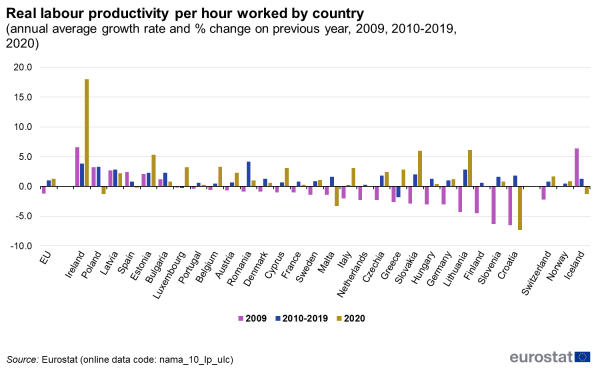
Source: Eurostat (nama_10_lp_ulc)
Analysing the effects of the COVID-19 crisis on EU countries’ labour productivity per hour worked (Figure 5 and Table 2) shows a wide variance across countries. Despite the challenges posed by the COVID-19 pandemic in 2020, the majority of countries experienced a positive growth in labour productivity per hour worked, due to relatively larger declines in hours worked than in GDP caused by COVID-19 lockdowns. Only Croatia (-7.3 %), Malta (-3.3 %), Poland and Iceland (both -1.3 %) registered a negative growth of labour productivity per hour worked. However, 2020 results should be compared across countries with caution as the registration of hours worked in relation to the government supports received may have differed across countries. Throughout the years 2021 and 2022, the majority of countries continued to affirm their positive trend in labour productivity per hour worked, even surpassing pre-COVID levels (as indicated by Table 2 index in the annex). However, in 2023, several countries experienced a decline, though their productivity levels remained above those recorded before the pandemic. Exceptions were Czechia, France, Luxembourg, Estonia, Italy and Finland, which saw their labour productivity levels fall below those of 2019.
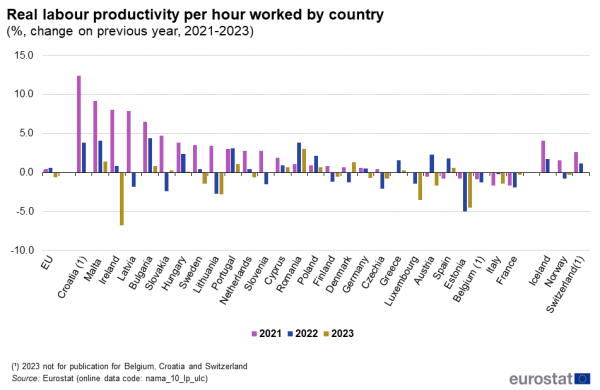
Source: Eurostat (nama_10_lp_ulc)

Source: Eurostat (nama_10_lp_ulc)
Labour productivity trends at industry level
Labour productivity indicators at total economy level have been complemented with breakdowns by economic activity to make it possible to analyse trends in specific industries (limited to industries where the vast proportion of activities are in the market sectors). Productivity levels and specific trends are very different across industries, and comparisons must be made with care. For example, outsourcing, and in particular outsourcing of services in manufacturing, often implies shifting activities across industries. This could alter levels and growth rates of productivity when the outsourced activities are more (or less) productive than the average in the industry. Focusing on the last decade, before the COVID-19 pandemic (2010-2019), labour productivity per hour worked by industry, calculated on the basis of real gross value added, showed overall positive trends at EU level (Figure 6, Tables 3 and 4). The largest increases were recorded for ’Agriculture’ (+3.0 %) and ’Information and communication’ (+2.4 %), and the smallest increases for ’Arts, entertainment and other service activities’ and ’Construction’ (both +0.3 %).
In 2020, the COVID-19 pandemic had a much greater-than-average impact on non-essential and contact-intensive industries. These industries saw a greater-than-average contraction of value added and hours worked. Labour productivity per hour worked sharply declined for ’Arts, entertainment and other service activities’ (-7.7 %), Construction (-0.3 %) and ’Wholesale and retail trade, transport, accommodation and food service activities’ also recorded a decrease (-0.2 %). On the positive side, labour productivity increased most for ’Information and communication’ (+3.3 %), ’Financial and insurance activities’, Industry and ’Agriculture’ (respectively 1.5 %, 1.3 % and 1.2 % ). In 2021, the strongest increases in labour productivity were registered in ’Manufacturing’ (+5.5 %), Financial activities (+2.6 %), ’Wholesale and retail trade, transport, accommodation and food service activities’ sectors (+1.8 %), while ’Construction’ and ’Arts, entertainment and other service activities’ continued to decline (-5.2 % and -2.6 % respectively). A rebound in labour productivity for ’Arts, entertainment and other service activities’ sector was registered in 2022 (+6.1 %), followed by +2.7 % in 2023. However, the pre-crisis level was still not reached. In 2022 productivity increased for most of economic activities, excluding ‘Agriculture’ and ‘Construction’ (-1.6 % and -1.1 % respectively). In 2023, productivity per hours worked declined in particular for ‘Manufacturing’ (-0.8 %), ’Wholesale and retail trade, transport, accommodation and food service activities’ sectors (-1.1 %), ’Financial and insurance activities’ (-0.9 %) and ‘Professional, scientific and technical activities (-0.4 %) and increased only for Agriculture and Construction (+3.4 % and +0.3 % respectively) with productivity levels in Construction still below the 2019 levels.
More detailed data on labour productivity per hour worked by country and by industry are presented in Table 3 and 4.
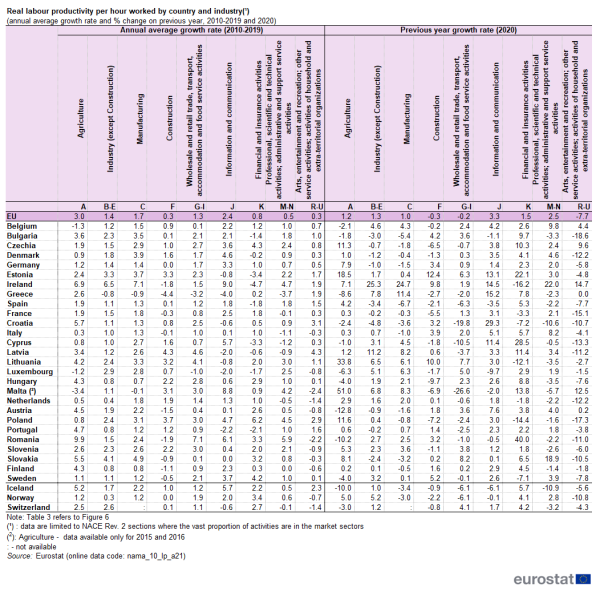
Source: Eurostat (nama_10_lp_a21)
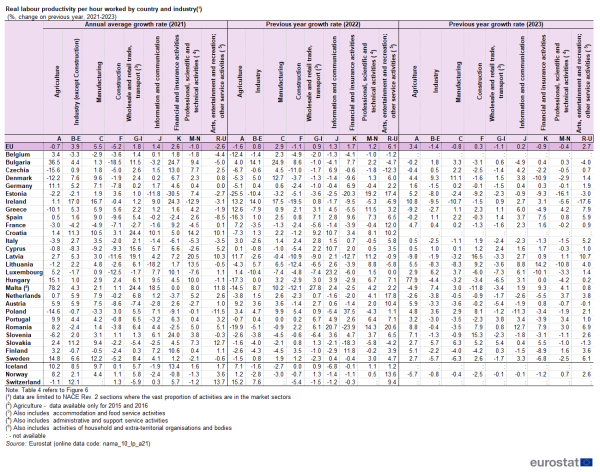
Source: Eurostat (nama_10_lp_a21)
Together with labour, capital is the other key input factor for the production process. EU aggregates for the new indicators (based on real net capital stock) are not yet available, since EU asset stocks have still to be estimated. However, some interesting aspects can still be pointed out for different countries over the period 2010-2019 also comparing it to 2020 and to 2021.
The following graph (Figure 7) presents a cross-country comparison of a proxy for capital productivity, measured as real gross value added per unit of net fixed assets. Analogous to the labour productivity indicator, this indicator shows the relation between the units of output (real gross value added) produced and one unit of capital stock (input). Over the period 2010-2019, the annual average growth rate of gross value added per unit of net fixed assets varied considerably across countries. A large majority of Member States recorded positive growth, in other words, on average, output grew faster than capital input (Table 5). The highest growth was registered by Malta (+3.8 %), followed by Latvia (+2.9 %) and Slovenia (+2.2 %). On the other hand, gross value added per unit of net fixed assets declined for a few countries, notably Ireland (-2.7 %) and Croatia (-1.1 %).
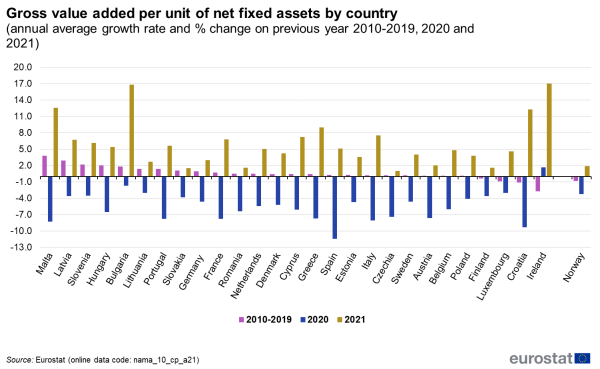
Source: Eurostat (nama_10_cp_a21)
The comparison of the average growth rate over the period 2010-2019 with the 2020 growth rate shows how the COVID-19 pandemic crisis impacted on gross value added per unit of net fixed assets (Figure 7). Since the net fixed assets is less affected by the cycle, the indicator broadly reacted to the dramatic drop of gross value added in 2020. The indicator registered a fall for all the countries, except for Ireland that in 2020 experienced a positive growth (+1.7 %). While the indicator rebounded sharply in 2021, pre-pandemic levels were reached and surpassed only for Malta, Latvia, Bulgaria and Ireland.
Finally, by looking at the capital-labour ratio it is possible to analyse the intensity of the use of fixed assets in relation to the use of labour input (Figure 8). Differences across countries are also related to different types of industry structure and technologies, which both imply different degrees of capital intensity compared with labour intensity.
Over the period 2010-2019, comparing net fixed assets per employed person and per hour worked (Figure 8), it can be seen that differences were usually minor. For most countries, the average annual growth rate of this ratio was positive, in other words, capital input grew more quickly than labour input, implying an increasing intensity in the use of capital in the production process. The country with the highest increase in capital input compared with labour input (in terms of persons employed) was Ireland (+6.6 %), followed by Romania (+3.4 %), Poland (+2.9 %) and Croatia (+2.2 %). In other words, in these countries the labour input grew more slowly than the capital input. On the other hand, Malta (-2.2 %) and Greece (-2.1 %) had the most negative average growth rates in this ratio, indicating a faster growth in labour input compared to capital.

Source: Eurostat (nama_10_nfa_st), (nama_10_pe) and (nama_10_cp_a21)
Over time, changes in the aggregate capital-to-labour ratio are basically driven by capital accumulation for most of the countries, especially in eastern and central European countries. Ireland ranked first thanks to the significant increase in fixed assets, especially impacted by the high level of addition of intellectual property products. Looking at 2020, the year of COVID-19 pandemic, the capital-to-labour ratio (table 5) increased for all countries (except for Malta, -1.2 % ) driven broadly by the positive growth of net fixed assets and the contraction of persons employed. Even though persons employed and fixed assets grew in most countries in 2021, changes in the capital-to-labour ratio increased varied across counties. It increased most for Slovakia, Latvia and Romania and declined most for Bulgaria, Ireland, France.
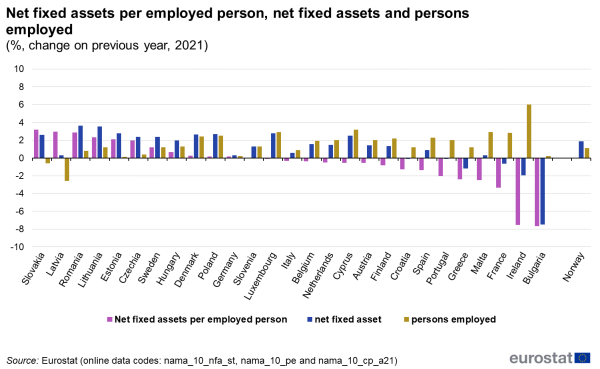
Source: Eurostat (nama_10_nfa_st), (nama_10_pe) and (nama_10_cp_a21)
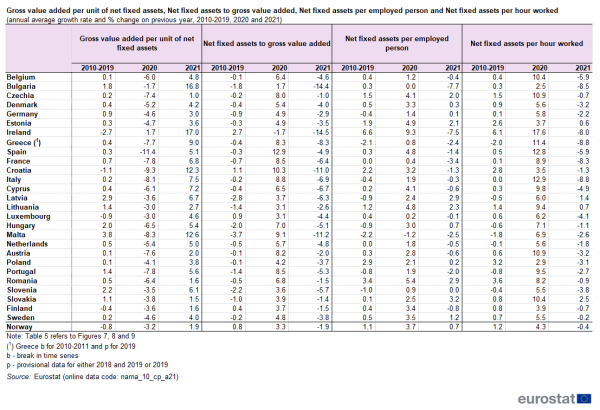
Source: Eurostat (nama_10_lp_a21)
Labour productivity per hour worked at regional level
Labour productivity can be analysed for regional accounts data available for the European Union’s (EU) NUTS level 2 regions. Several Member States (Cyprus, Estonia, Luxembourg, Latvia and Malta) only have a single level 2 region, in these cases the regional labour productivity indicator corresponds to the one at national level.
Regional labour productivity per hour worked is computed as an index (2015=100) based on gross domestic product in chain linked volumes. In order to smooth out the volatility typically observed in regional growth year on year, the annual average growth rate was calculated over the period 2003-2021. The following map illustrates regional growth in labour productivity for the EU regions.
- Map 1: Labour productivity, annual percentage growth rate by NUTS 2 regions, EU, 2003-2021
- Source: Eurostat (nama_10r_2rlp)
- Map 1: Labour productivity, annual percentage growth rate by NUTS 2 regions, EU, 2003-2021
At regional level, productivity growth was higher for central and eastern European countries, which benefited from a catching-up and convergence process over the period, with a generally higher annual average growth rate for all regions of Bulgaria, Czechia, Lithuania, Hungary, Poland, Slovenia, Slovakia. All regions in Denmark, Ireland, Austria, some regions in Portugal, Spain and several regions in Germany also had annual growth rates above the EU average (the EU average was 1.0 %). The growth rate for the Romanian region of the București-Ilfov (7.9 %) was the highest among the European regions while productivity growth was rather low for all Greek and some Italian regions.
Source data for tables and graphs
Data sources
The available set of productivity indicators is based on national accounts data which must be sent by EU Member States and EFTA countries according to the deadlines specified in the European system of national and regional accounts (ESA), which also provides the methodological framework for national accounts in the EU. The current version, ESA 10, was adopted in May 2013 and has been implemented since September 2014. It is fully consistent with worldwide guidelines for national accounts, the 2008 SNA.
Please note that national accounts data are regularly revised, and this also impacts derived productivity indicators. In particular, significant revisions can be expected for benchmark revisions. Most EU Member States carried out revisions in 2019 and 2020. For further details, please consult the Eurostat website and in particular this document. The next coordinated benchmark revision is planned for 2024.
Regular updates vary depending on the breakdown and national release calendars. Deadlines for delivery of data range mainly from t+2 months for main aggregates to t+24 months for capital assets and regional data. Additional information on the dissemination of ESA 2010 data is available under National accounts based productivity indicators at total economy, industry and regional level (nama_10_prod) and for regional accounts Regional economic account (reg_eco10) - Section 9. Frequency of dissemination.
Indicator definitions
Real labour productivity per person employed for the total economy is calculated by dividing GDP in chain-linked volumes by the number of employed persons. At industry and regional levels, GDP in the numerator is replaced by GVA.
Real labour productivity per hour worked for the total economy is calculated by dividing GDP in chain-linked volumes by hours worked. At industry and regional level, GDP in the numerator is replaced by GVA. The recommended measure for labour input is the total number of hours worked, as it takes into account changes in part-time work, the effect of variations in overtime, the effect of absence from work, or the effect of shifts in normal hours.
Total employment per capita is calculated by dividing total employment (in terms of persons, in domestic concept) by the total population.
Hours worked per person employed is the result of dividing total hours worked by persons employed (in domestic concept).
Gross value added per unit of net fixed assets is obtained by dividing gross value added (in chain-linked volumes) by net capital stock (in chain-linked volumes).
Net fixed assets to gross value added is the inverse of the previous indicator. It is obtained by dividing net capital stock (in chain-linked volumes) by gross value added (in chain-linked volumes).
Net fixed assets per employed person is obtained by dividing net capital stock (in chain-linked volumes) by persons employed; net fixed assets per hour worked is obtained by dividing net capital stock (in chain-linked volumes) by hours worked.
Context
Labour and capital are key input factors affecting productivity growth. They are widely used for economic analysis and forecasting, policy design and policy making. The aim of this data collection based on national accounts data is to provide indicators that allow deeper analysis of productivity trends.
Direct access to
Other articles
Database
- National accounts based productivity indicators at total economy, industry and regional level (nama_10_prod)
Dedicated section
National accounts (including GDP and regional accounts) - Overview
Methodology
The documentation on availability and comparability aspects related to labour-productivity indicators and capital-productivity indicators is available on the Eurostat website.
Legislation
- Regulation (EC) No 1392/2007 of 13 November 2007 amending Regulation (EC) No 2223/96 with respect to the transmission of national accounts data
- ESA 2010 Introduction
